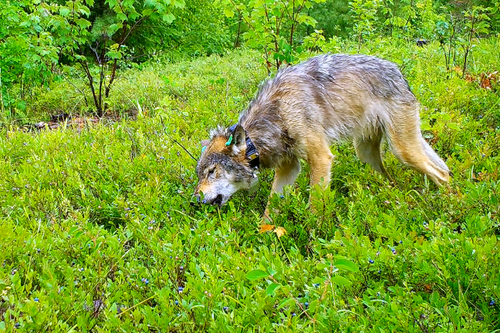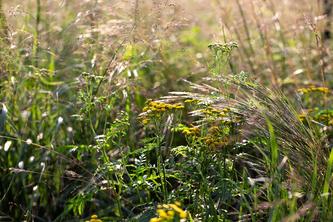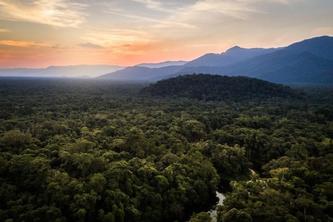
Recently published research from the University of Minnesota reveals new details about wolves' diets, concluding wolves consume large amounts of blueberries in the summer and even provision their pups with blueberries.
Thomas Gable, project lead for the Voyageurs Wolf Project and a Ph.D. student at the U of M, discusses the role berries play in wolves' diets and ongoing research about the habits of northern Minnesota's wolf population.
Q: What do wolves in Northern Minnesota eat during the winter and how does this differ from the summer?
Gable: In the winter time, wolves in the Greater Voyageurs Ecosystem — where our research occurs — mainly hunt and kill deer, though wolves do kill the occasional snowshoe hare and, rarely, a moose. During the summer, wolf diets are much more varied than in the winter, primarily because there are more food sources available, and wolves are really good at taking advantage of different foods. During the summer, wolves in our area mainly eat beavers, deer fawns and blueberries, with wolves also relying, at times, on fish, bear bait piles, road-killed deer, snowshoe hares and the gut piles of hunter-killed bears. While infrequent, we have also documented wolves killing trumpeter swans, moose, geese, raccoons, painted turtles and muskrats.
Q: Are the summer diets of wolves in the Greater Voyageurs Ecosystem similar to other places in Northern Minnesota?
Gable: Wolves in the Greater Voyageurs Ecosystem appear to eat far more beavers than wolves in many other places in Northern Minnesota. Beavers can actually be the primary summer prey of some wolf packs, making up to 42 percent of wolf pack diets from April to October in our area. This reliance on beaver is likely because we have a much larger beaver population in the Greater Voyageurs Ecosystem than the rest of the state. Wolves in our area also appear to rely on blueberries much more so than wolves in other parts of the state.
Q: What have you learned about wolves eating blueberries during the summer?
Gable: Each of the eight packs that we have studied has eaten blueberries when they are abundant in July and August. In fact, blueberries can make up to 83 percent of the weekly diet of our wolf packs in July. Clearly wolves in our area are spending a lot of time eating blueberries when they are available.
In July 2017, Austin Homkes, a field biologist with the Voyageurs Wolf Project, fortuitously observed an adult wolf regurgitate blueberries to five wolf pups. This really surprised us because it showed that adult wolves will actually provision their pups with blueberries, which suggests that wolves view blueberries as a valuable food source for rearing pups. This also surprised us because it is the first documented observation of a wolf feeding wolf pups berries or fruits of any kind.
We are going to continue studying this berry-eating behavior, and we hope to determine how valuable a food source berries actually are. In particular, we want to know if blueberries impact the number of prey — mainly, deer fawns and beavers — wolves kill during July and August.
Q: Has the Voyageurs Wolf Project ever actually observed wolves eating blueberries?
Gable: We have never watched wolves eating berries in person, and in 2018, we set up remote cameras in berry patches to get video footage of wolves eating berries, but were unsuccessful. Then last summer, we put out a bunch of cameras and were ecstatic when we captured a lot of footage of wolves eating berries — likely a first for wolves in a boreal forest environment like Voyageurs.
Q: Other than wolves eating blueberries, what does the Voyageurs Wolf Project study and what is the goal of the project?
Gable: Our project is focused on providing a detailed understanding of what wolves do during the summer. To do this, we intensively study wolf predation behavior and wolf pup-rearing behavior between April to October (the period, generally speaking, when there is no snow or ice). We do this because wolves do two things during the summer: they raise pups and they hunt and kill food to feed their pups and themselves.
We study wolves during summer by putting GPS-collars on them and then visiting everywhere our collared wolves remain stationary for more than 20 minutes. This requires a huge amount of hiking and time in the forests, but it has provided us with wonderfully detailed information on the habits of wolves during the summer. If you want to see and learn more about our project, follow us on Facebook or Instagram where we share pictures, maps, videos and findings from the project several times a week, or visit our website (voyageurswolfproject.org).
Tom Gable is the project lead for the Voyageurs Wolf Project and a Ph.D. student at the University of Minnesota in the Department of Fisheries, Wildlife, and Conservation Biology. He has been studying wolves in the Greater Voyageurs Ecosystem since 2014 when he started his Master's at Northern Michigan University. Most of Gable’s research has been focused on understanding wolf ecology during the summer in boreal ecosystems.
Major support for the Voyageurs Wolf Project is provided by the the Minnesota Environment and Natural Resources Trust Fund, as recommended by the Legislative-Citizen Commission on Minnesota Resources, Voyageurs National Park, the Department of Fisheries, Wildlife, and Conservation Biology at the University of Minnesota and the Van Sloun Foundation.
About “Talking...with U of M”
“Talking...with U of M” is a resource whereby University of Minnesota faculty answer questions on current and other topics of general interest. Feel free to republish this content. If you would like to schedule an interview with the faculty member or have topics you’d like the University of Minnesota to explore for future “Talking...with U of M,” please contact University Public Relations at [email protected].
- Categories:
- Agriculture and Environment





